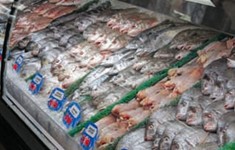 In the era of large supermarkets and mass merchandisers, many independent fish markets are still flourishing. It seems that the successful mom-and-pop operators across the nation have a few qualities in common, helping them survive competition from grocery stores, large fish markets and other seafood retailers.
In the era of large supermarkets and mass merchandisers, many independent fish markets are still flourishing. It seems that the successful mom-and-pop operators across the nation have a few qualities in common, helping them survive competition from grocery stores, large fish markets and other seafood retailers.All single-store operators agree that good old-fashioned quality and service are the keys to their success. While shoppers may cut back in other areas, they tend to pay for quality seafood, says Charlotte Sasso, co-owner of Stuart’s Seafood in Amagansett, N.Y.
“Consumers have a high expectation of seafood compared to any other protein. Even though it is a tight economy and people are very price conscious, they will pay more for quality seafood,” Sasso says.
Offering shoppers high quality, local seafood and personal attention sets Stuart’s Seafood apart from grocery stores, she adds. “Most supermarkets or warehouse clubs are not going to have people with the knowledge and dedication,” Sasso says. In addition, employee turnover in independent stores is often less than in supermarkets, she believes. “Our staff stays here, but we have a lot of benefits and extra perks. We serve a hell of a staff lunch.”
Tim Caluya, owner of Tim’s Seafood in Kirkland, Wash., also believes the quality and freshness of the product sets his store apart from chains. Tim’s Seafood buys all of its local seafood from day-boats that use only long-line fishing. “All we do is seafood. If we are going to do just seafood, we have to be better,” Caluya says.
Tony Lombardi, owner of Lombardi’s Marketplace in Orlando, Fla., also believes quality is one of the primary keys to success. “It is sourcing top-of-the-line product and it is also the variety we have,” Lombardi says. Offering value to customers is also what has kept him in business since 1961. “We try to make sure our prices are competitive with Publix, Whole Foods and other stores.”
Having knowledgeable employees who are friendly to customers also makes a big difference in sales, according to fish market owners. “We have some real pleasant college kids working for us,” Lombardi says.
Lombardi’s sales have grown around 40 percent over the last two years, after the 52-year-old company added a wholesale element to the business and remodeled its retail space. In its 4,000-square-foot store, Lombardi’s added a 12-foot deli case with prepared items such as fish smoked in-house and shucked oysters along with non-seafood items like produce and desserts. The store also offers three hot seafood soups daily.
“The deli helps us utilize the different products that may not be sold in the store. We are also working with a chef to develop more take-home items that customers can take home and eat,” Lombardi said.
Stuart’s also benefits by offering prepared gourmet seafood dishes and catering clam bakes and lobster dinners during the summer. The retailer’s most popular prepared dishes include clam chowder, lobster bisque, crab cakes and Cedar Plank Salmon with Ginger Teriyaki Glaze.
Tim’s Seafood has also developed a unique service that has helped boost the retailer’s bottom line: mail order. “We have a big shipping business: people have followed me from other markets that I worked at,” Caluya says. Loyal customers often have Tim’s ship the first Copper River salmon to them. The store delivers fresh seafood to hotel rooms or to the airport, where seafood is waiting for customers in a secure baggage area when they get off the plane.
Tim’s Seafood Market also does well during Copper River salmon season by calling customers who have previously ordered the fish by mail. Caluya encourages them to stock up on seafood items that have short seasons. “I portion, vacuum-pack and freeze the fish. Then, they can store it until next year’s opening,” Caluya says.
Another extra service that many customers do not get at a supermarket seafood counter, according to Calyua, is education. “I like to make sure they know how to cook the seafood. If it comes out perfect for them, they will thank us and tell everyone about us,” Caluya says.
Looking ahead, the biggest challenge independent markets face is rising wholesale seafood prices. “Wholesale seafood often prices itself out of everyone’s range. It is a fine line — how high do my prices go and do I stop carrying the products?” Caluya asks. For example, last year’s shortage on king crab and snow crab sent prices soaring. “Chinese buyers were paying top dollar and keeping prices inflated in the U.S. market,” Caluya adds.
Lombardi says shoppers are still price-conscious on such higher-end items. “Currently, stone crabs are a good Florida product and you can make nice margins on it. However, because of the price points on it, it is a little harder sell in this economy,” Lombardi says.





